1. INTRODUCTION
Wooden structures in Korea have long been characterized by the use of a variety of wood species, including hardwoods, such as oak species (Quercus spp.) and Korean castanea (Castanea crenata), as well as softwoods, such as Korean red pine (Pinus densiflora) and Korean white pine (Pinus koraiensis). For example, it was confirmed that Quercus acutissima, C. crenata, Quercus serrata, and P. densiflora were used as building materials in a large number of boards and construction materials excavated from the timber cluster of the Asan Galmaeri site, dated to the 3rd–5th centuries (Korea University Institute of Archaeological Environment, 2007). In addition, P. koraiensis and Q. serrata were used as lower foundation members for the stone piers of Woljeonggyo Bridge in Gyeongju (Cultural Heritage Administration, 1988), and Quercus spp. and Castanea crenata were used as columns for Chunyang Bridge in Gyeongju (Gyeongju National Research Institute of Cultural Heritage, 2005). Wood species, such as Q. acutissima, Castanea spp., and Morus spp., were used as attachments in building materials excavated from Wolseong moat, a Silla royal site (Lee, 2007). Park and Lee (2007) reviewed research reports and academic papers on excavated building materials from the prehistoric times and Three Kingdoms period and reported that, during these times, various hardwood species, mainly Quercus spp., were used as building materials. However, the analysis of wood member species used in 172 important Korean architectural cultural properties (national treasures) and 40 significant temples and pavilions built by the Late Goryeo Dynasty showed that Pinus spp. was dominantly used in 97.0% of important wooden cultural properties and 91.9% of temples and pavilions, and other members were identified as P. koraiensis, Abies holophylla, Zelkova serrata, C. crenata, and Quercus spp. (National Research Institute of Cultural Heritage, 2015a, 2015b, 2016a, 2016b).
A survey conducted in 2018–2019 to investigate the damage caused by the termite infestation of wooden cultural properties confirmed that 486, i.e., approximately 17.3%, of a total of 2,805 wooden cultural properties nationwide were infested with Reticulitermes speratus, a domestic subterranean termite. In 143 cases (29.4%), subterranean termite infestation and wood damage were ongoing during the survey (Im et al., 2021). Considering the nationwide status of termite damage in Korea, identifying the termite resistance of domestic wood species mainly used as building materials will be helpful for the overall management of wooden cultural properties and wooden buildings.
Amburgey and Beal (1977) and Nobre et al. (2001) reported that the characteristic preferences of termites for wood species are determined by the interaction of various factors such as the degree of decay caused by wood-decay fungi, wood species, and termite species. Cornelius et al. (2012) also noted that reduction in wood density because of the decomposition of cellulose and lignin caused by wood-decay fungi and the detoxification of termite-resistant extracts are the major factors that promote termite feeding. However, the deterrent effect of wood extracts on the feeding activity of termites depending on the wood species has also been reported, and this phenomenon is caused by various toxic and repellent substances contained in woody and herbaceous plants (Wolcott, 1957). Shibutani et al. (2004) confirmed the inhibitory effects of stilbenes extracted from Picea glehnii bark on the feeding activity of R. speratus. Resistance to termites varies depending on various elements present in a wood, such as saprophytic fungi and extracts. Therefore, it is essential to identify the feeding tendencies of R. speratus and the resistance of wood species used as wood members in wooden buildings R. speratus to prevent the continued damage to wooden cultural properties caused by this subterranean termite species.
In this study, we aimed to determine the inherent termite resistance of wood species that are used for cultural properties. In addition, we examined how the extracts of the major tree species affected termite-feeding activities. Determining the feeding tendency of R. speratus, which causes damage to wooden cultural properties nationwide, is expected to provide basic data for the effective management of wooden cultural properties and to search for termite control materials in future studies.
2. MATERIALS and METHODS
Termite-infested logs were collected from the forests in Sejong and Cheongju cities and stored in plastic boxes under environmental conditions of 20 ± 4°C and humidity above 90% with air circulation. A cardboard was placed in a storage container immediately before the start of the experiment to allow the termites to migrate to the cardboard and be separated from the wood log without decomposition.
For the species identification of subterranean termites, their genomic DNA was extracted using DNeasy? Blood & Tissue Kit (QIAGEN, Hilden, Germany), and polymerase chain reaction (PCR) amplification was performed using HKGampTM X-Taq DNA Polymerase Premix-Hot Start Version (HK Genomics, Daejeon, Korea) and the cytochrome oxidase subunit I (COI) gene specific primers (LCO-1490 and HCO-2198) to obtain the COI barcode sequence of mitochondrial DNA. The PCR assay conditions were 35 cycles (1 cycle of denaturation at 95°C for 30 s, annealing at 50°C for 30 s, and extension at 72°C for 45 s), with initial denaturation at 95°C for 5 min before the first cycle, and a final extension at 72°C for 5 min immediately after the 35th cycle. The COI sequence (658 bp) of subterranean termite obtained by PCR analysis was identified using GenBank and the Barcode of Life Data System. The subterranean termite used in the experiment was identified as R. speratus (Table 1).
| Gene | Primer name | Primer sequence (5′→3′) | Sense | References |
|---|---|---|---|---|
| Cytochrome oxidase subunit I (CO I) | LCO1490 | GGTCAACAAATCATAAAGATATTGG | Forward | Folmer et al. (1994) |
| HCO2198 | TAAACTTCAGGGTGACCAAAAAATCA | Reverse | ||
| Amplification parameter | Initial denaturation: 95°C for 5 min; 35 cycles: 95°C for 30 s, 50°C for 30 s, 72°C for 45 s; final extension: 72°C for 5 min | |||
Based on the ecological characteristics of R. speratus, which feeds exclusively on felled or dead wood, we collected wood specimens with confirmed damage because of R. speratus infestation damage from two forests (9.64 ha) in Cheongju City and identified the wood species. The collected samples were washed with distilled water to remove debris generated through the feeding activity of R. speratus and then sliced into three sections. The sections were sequentially dehydrated in ethyl alcohol and embedded in a sealant to prepare them for tree species analyses. The wood tissues were then observed under a light microscope (Eclipse Lv 100; Nikon, Melville, NY, USA), and their anatomical features were compared to identify the wood species.
The National Cultural Property Research Institute has published reports titled “Report on the Results of the Survey on the Species Affecting Wooden Cultural Properties” annually between 2014 and 2019 (National Research Institute of Cultural Heritage, 2014, 2017, 2018, 2019), which provide detailed information on nationally designated wooden cultural properties affected by termites. Subsequently, the characteristics of the identified wood species were compared with those of wood members of these nationally designated wooden cultural properties. The results were analyzed to collect information regarding the wood species of damaged wood members based on the following reports: “Research Report on Tree Species of Important Palaces and Government Buildings (2015)” and “Research on Tree Species of Important Temples and Local Schools (2016)” published by the National Research Institute of Cultural Heritage and “Tree Species Composition of Major Wooden Cultural Properties (2005)” published by the National Institute of Forest Science. These reports provide information regarding the wood species used in nationally designated wooden cultural properties in Korea, many of which have been damaged by subterranean termites.
The wood species tested were P. densiflora, Larix kaempferi (Japanese larch), P. koraiensis, A. holophylla (needle fir), and Ginkgo biloba (maidenhair tree) as softwood. For hardwoods, we chose Paulownia coreana (Korean paulownia), Quercus variabilis (Oriental cork oak), Z. serrata (sawleaf zelkova), Prunus sargentii (Sargent’s cherry), and C. crenata. These wood species were selected based on the existing research on termites and wooden cultural properties (Lee, 2004; National Institute of Forest Science, 2005; National Research Institute of Cultural Heritage, 2015a, 2015b, 2016a, 2016b; Park and Lee, 2007; Table 2).
Wood specimens with the dimensions of 20 mm (T) × 20 mm (R) × 10 mm (L) were prepared. The wood specimens were immersed in distilled water for 24 h before testing. Subsequently, the specimens were removed from the water and wiped dry immediately before use. In addition, wood specimens that had undergone pretreatments, such as cold-water or alcohol–benzene extraction, were dried at 60°C for 48 h after these pretreatments. The dried specimens were measured for wood dry weight and then soaked in distilled water for 4 h to provide internal moisture. The surface was wiped dry before use.
Termite resistance tests were conducted in cylindrical vials with diameter and height of 40 and 80 mm, respectively. A 6-mm diameter hole was drilled at a height of 30 mm to provide a pathway for the termites to move through. A substrate for maintaining the humidity in the experimental space was prepared and used based on Lee and Forschler (2016). Silica sand and vermiculite were mixed in a 7:6 (w/w) ratio and sterilized. Approximately 40 g of sterilized substrate was placed inside the vial, with the substrate filled to the level of the 6-mm diameter hole drilled into the wall to facilitate the entry and exit of worker termites (Fig. 1).
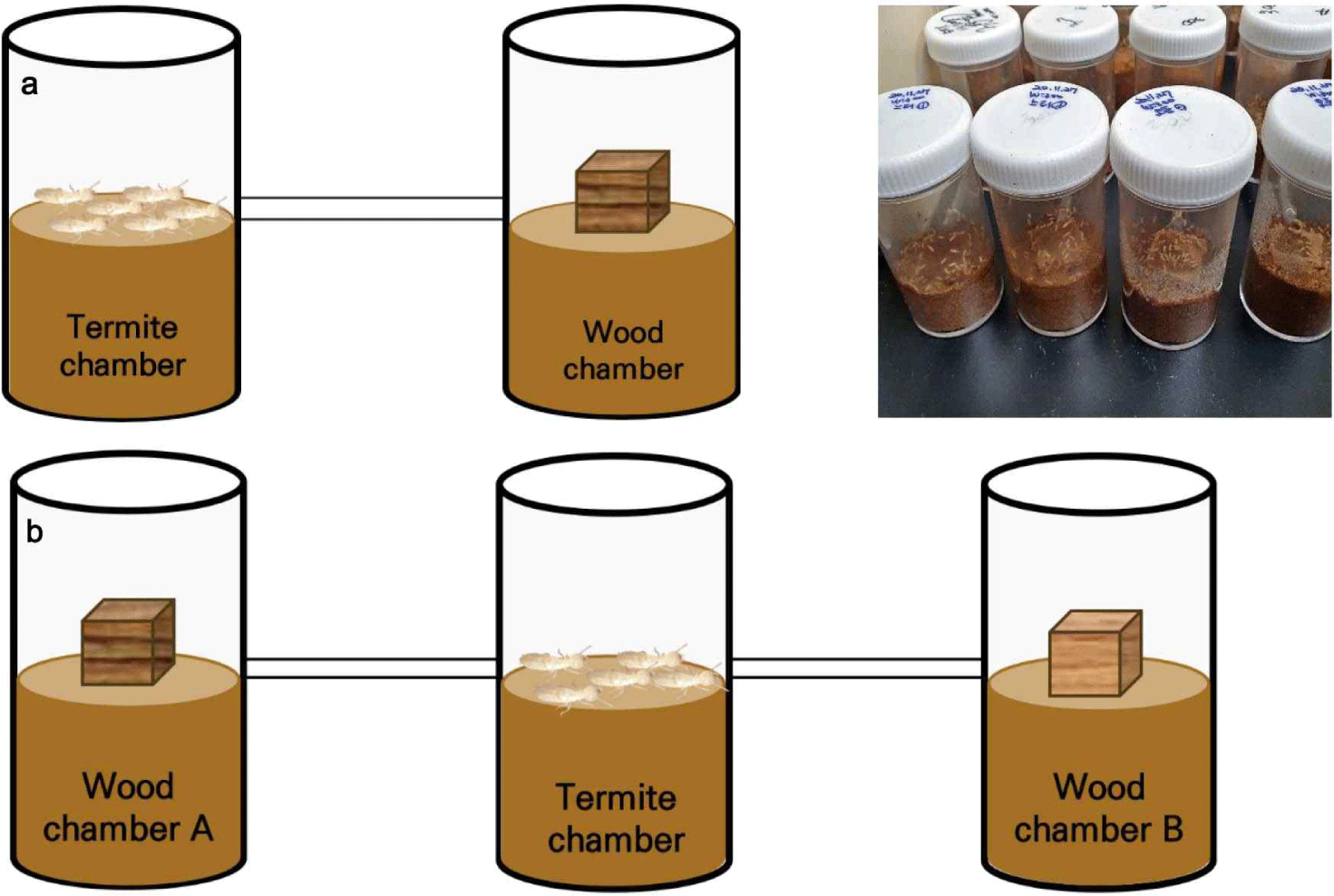
The experimental design for the no-choice test consisted of two cylindrical vials connected by a 100 mm plastic tube with an inner diameter of 4 mm [Fig. 1(a)]. The left cylindrical vial (termite chamber) contained 300 workers, and the right cylindrical vial (wood chamber) contained wood specimens. A visual evaluation of termite resistance was performed based on the grading criteria specified in the Indonesian National Standard (SNI) 01.7207 (BSN, 2014), American Standard Test Method (ASTM) D3345 (ASTM, 2022), and American Wood Protection Association (AWPA) E1-16 (AWPA, 2016). For SNI 01.7207, the grading scale was defined as follows: 1, extremely resistant; 2, resistant; 3, moderate; 4, poor; and 5, extremely poor. Similarly, for ASTM D3345 and AWPA E1-16, the grading scales were defined as follows: 10, sound, surface nibbles permitted (sound); 9, light attack (slight); 7, moderate attack, penetration (moderate to severe); 4, heavy (extremely severe); and 0, failure. The degree of damage to the wood samples was calculated based on five levels of the three standardized test methods, and termite resistance was evaluated for each species. The experiment lasted for 3 weeks, and at the end of the experiment, termite mortality rate and wood consumption rate were evaluated for each wood species.
We conducted a two-choice test to compare the selective termite resistance of four main wood species (P. densiflora, P. koraiensis, A. holophylla, and Z. serrata) used as wood members in wooden cultural buildings. Three cylindrical vials were connected. A total of 300 workers were placed in the cylindrical vial in the center (termite chamber), and wood specimens were placed in the left and right cylindrical vials [wood chambers A and B, respectively; Fig. 1(b)]. First, the connecting passages on both sides were blocked for 24 h to allow the workers to stabilize through sufficient tunneling into the substrate inside the cylindrical vials (termite chamber). After stabilization, the termite chamber was connected to the wood chambers on either side, and then wood specimens from different wood species were introduced and left for 3 weeks. A scoring system was used to determine the resistance of each species quantitatively. Based on the visual observations made in the 3 standardized test methods used for the no-choice test, 1, 2, and 1.5 points were assigned to wood species with relatively severe damage, less severe damage, and no significant difference, respectively. The scores derived from comparison tests with the other three wood species were summed to provide a quantitative estimate of termite resistance for each of the studied wood species.
The extracts of three softwood species (P. densiflora, L. kaempferi, and A. holophylla) and four hardwood species (Q. variabilis, C. crenata, P. sargentii, and Z. serrata) were tested for their termite resistance. Cold-water extraction was performed according to the Japanese Industrial Standard K 1571 (Japanese Standard Association, 2010) by immersing the wood specimens in distilled water with its volume 10 times that of the wood specimen and stirring with a magnetic stirrer at 400–450 revolutions/min for 8.0 h. The wood was then stirred for 16 h at 60 ± 2°C to volatilize the volatiles. This process was repeated 10 times. Wood specimens used for alcohol–benzene extraction were prepared as 1 cm × 1 cm × 1 cm cubes for insertion into a thimble filter (Grade 84, Advantec, Tokyo, Japan). Alcohol–benzene extraction was performed using a Soxhlet apparatus. A thimble filter with wood specimens was placed in the upper part of the Soxhlet apparatus, and 240 mL of alcohol–benzene solution (ethanol:benzene = 1:2, v/v) was placed in the lower part of the round bottom flask. After the alcohol–benzene solution and wood specimens were added, the cassette was immersed in a water bath (C-WBA, Chang Shin Science, Seoul, Korea) set at 80°C for 72 h for organic solvent extraction. The wood specimens before and after extraction were dried in a 60°C hot air dryer for 48 h and weighed to determine the amount of extraction for each wood species.
The no-choice test was performed on wood specimens subjected to untreated, cold-water, and alcohol–benzene extraction under the conditions described in Section 2.4. to determine the difference in termite resistance based on extraction conditions. In addition, to check the termite resistance of the wood specimens subjected to alcohol–benzene extraction, the weights of the wood specimens of each species were measured before and after extraction. For each wood species, we applied an amount of extract equal to the loss in the mass of its wood specimen because of its dissolution during the extraction process to a filter paper (C1.F001, CHMLAB, Daejeon, Korea) of 55 mm diameter and volatilized in a fume hood for 24 h. A Petri dish (Catalog # 10090, SPL Life Sciences, Pocheon, Korea) was filled with 40 g of the substrate used in Section 2.4. Test of termite resistance of wood species to maintain humidity. Termites (200 workers + 5 soldiers) were placed inside, fed filter paper with extracts of each wood species, and sealed with Parafilm (PM996, Bemis, Sheboygan Falls, WI, USA). After a week of forced feeding on filter papers containing the extracts of each wood species, we compared the proportion (%) of the filter paper consumed by the introduced termites and the mortality rate of these termites feeding on different wood species. To calculate the area of the filter paper consumed by R. speratus, the pixel values of the image files were measured using ImageJ ver. 1.8 (LOCI, Wareham, MA, USA) to obtain quantitative values.
Statistical analysis was performed to distinguish and compare the differences between experimental conditions using the analysis of variance in SPSS Statistics 26 (IBM, Armonk, NY, USA). Tukey’s honestly significant difference post hoc test was used for post hoc comparisons, and the results are expressed as mean ± SD.
3. RESULTS and DISCUSSION
Wood specimens from 13 termite-damaged trees of the family Pinaceae within the forest were collected and identified at the species level. Of these, six members were identified as hard pines, two as Pinus rigida (lodgepole pine), three as Prunus spp., and two as Quercus spp. (Table 3). These results confirm that R. speratus can feed on wood from various broadleaf tree species, contrary to the common belief that it feeds only on Pinus spp. Moreover, these results can be attributed to the dissolution of extractives through precipitation and ground moisture under natural conditions and the reduction of specific gravity caused by saprophytic fungi and insects, allowing R. speratus to feed not only on Pinus spp. (pine) but also on Prunus spp. (cherry) and Quercus spp. (oak) wood. These results are consistent with the findings of Son (2018), who reported that the feeding activity of subterranean termites in forests was observed on Quercus acutissima (sawtooth oak) and pines. Therefore, it is likely that R. speratus plays the role of a decomposer in natural ecosystems by feeding on a variety of wood species, including conifers and hardwood species, rather than exclusively on Pinus spp.
Comparing the results of wood species identification studies conducted on wooden cultural properties with those of subterranean termite damage surveys, we confirmed 27 wood columns wherein wood species damaged by termites were identified between 2014 and 2019 (Table 4). More than 90% of wood species damaged by subterranean termites were Pinus spp., which is consistent with the findings of Park and Lee (2007), who reported that the use of Quercus spp. for wood decreased from the Three Kingdoms period to the Goryeo and Joseon periods, whereas the use of pine wood increased. In addition, the wood species analysis of the wood members of 172 significant architectural and cultural properties (national treasures) in Korea showed that hard pines dominate with 17,780 samples (96.97%) of the total 18,541 samples (National Research Institute of Cultural Heritage, 2015a, 2015b, 2016a, 2016b). Therefore, it can be concluded that Pinus spp. appeared to be relatively more susceptible to termite damage than the other wood species, mainly because of the dominant use of pine wood in most wooden cultural properties in Korea.
Data from National Institute of Forest Science (2005).
On the contrary, termite damage was also confirmed in wooden cultural properties that used wood from Z. serrata and Quercus spp. as pillars, such as in the Geungnakbojeon Hall of Muwisa Temple, Yaksajeon Hall of Gwallyongsa Temple, and Upper Daeungjeon Hall of Janggoksa Temple. Therefore, it is believed that wooden structures built with hardwood species, such as Z. serrata and Quercus spp., can also be damaged by termites if exposed outdoors for long periods, depending on the environment wherein they are located.
In a 3-week no-choice test to determine the resistance to the termite R. speratus in 10 native Korean tree species, the highest feeding rate of 19.3% was recorded for L. kaempferi, followed by the termite feeding rates of 17.6%, 16.5%, 15.5%, and 14.2% recorded for P. densiflora, P. koraiensis, A. holophylla, and P. coreana, respectively (Table 5). In addition, the mortality rate of R. speratus feeding on the five softwood species, i.e., L. kaempferi, P. densiflora, P. koraiensis, A. holophylla, and G. biloba, was found to be within 10%–15% on average, which was relatively lower than the 15%–25% mortality rate of R. speratus feeding on the hardwood species (Table 5). The trend of high feeding rates and low mortality in the five softwoods, including L. kaempferi, suggests that these species have low termite resistance to R. speratus. The feeding rate of R. speratus on L. kaempferi and P. densiflora, two of the lowest termite-resistant wood species, was not significantly different from that of Reticulitermes virginicus on Pinus spp. (20.8%) under the same conditions (Lee and Forschler, 2016).
However, the feeding rate of R. speratus for hardwood species, such as Q. variabilis, Z. serrata, C. crenata (Korean chestnut), and P. sargentii, was 4%–6%, which is lower than that for softwood species. There was a significant difference in the feeding trends of R. speratus for different wood species. The feeding rate of R. speratus for Q. variabilis and C. crenata was 3%–4%, which was the lowest among the 10 wood species studied herein; however, the mortality rate of R. speratus when feeding on these hardwood species was 15%–18%, which was the same as that when feeding on softwood species. In particular, the feeding rate of R. speratus on P. sargentii and Z. serrata was only approximately 6%, less than half of its feeding rate on softwood; however, its mortality rate was the highest at 27%–32% when feeding on P. sargentii and Z. serrata (Table 5). On the contrary, for hardwood P. coreana, the feeding and mortality rates of R. speratus were approximately 14% and 20%, respectively, which were not significantly different from the feeding and mortality rates of R. speratus for softwood. Accordingly, hardwood species, excluding P. coreana, were confirmed to have higher termite resistance to R. speratus than that exhibited by softwood species.
Based on the grading of termite resistance by wood species following the visual observation standards specified in standard test methods, such as SNI 01.7207 (BSN, 2014), ASTM D3345 (ASTM, 2022), and AWPA E1-16 (AWPA, 2016), softwood was rated 4 or 5 (4: poor; 5: extremely poor) in SNI 01.7207 and 4–7 (4: extremely severe; 7: moderate to severe) in ASTM D3345 and AWPA E1-16. Therefore, termite resistance was low in softwood. However, hardwood was rated 2 (resistant) based on SNI 01.7207 and 7–9 (slightly resistant) according to ASTM D3345 and AWPA E1-16, and visual observations also confirmed that there was relatively less damage in hardwood than in softwood (Fig. 2). C. crenata was found to have the highest termite resistance, with grade 2 for SNI 01.7207 and grade 9 for ASTM D3345 and AWPA E1-16. Likewise, the results of the visual observation analysis confirmed that the termite resistance of hardwood was higher than that of softwood, which was consistent with the results of feeding and mortality rate analyses.
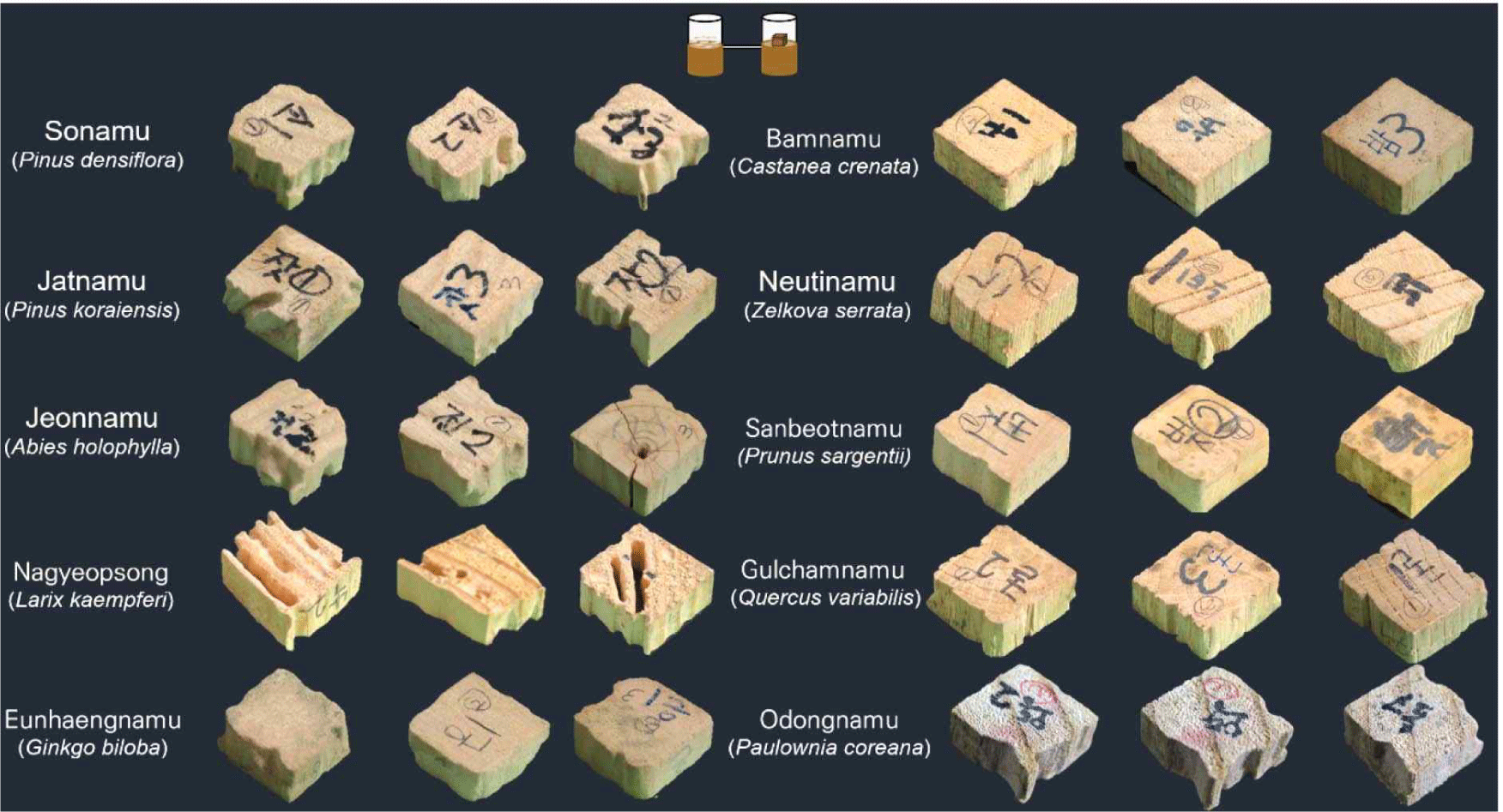
When comprehensively judged based on the results of the no-choice test for feeding and mortality rates and visual observations, the termite resistance of hardwood species was found to be relatively higher than that of softwood species. The wood species with the highest termite resistance were C. crenata and Z. serrata. The feeding and mortality rates of R. speratus for these wood species were low and high, respectively, and termite damage was rarely observed visually. Differences in feeding and death rates between wood species are believed to be because of the differences in the specific gravity and extractives of their wood (Williams, 1934).
Assuming that the specific gravity of wood is a major factor affecting the feeding and mortality rates of R. speratus, its feeding rate for wood species with a specific gravity of 0.3–0.5 was 13%–20% (excluding C. crenata, which has a specific gravity of approximately 0.5). This feeding rate is relatively higher than that for wood species, such as Z. serrata, P. sargentii, and Q. variabilis, with a high specific gravity of 0.6 or more. These results are consistent with the findings of Behr et al. (1972) that the feeding tendency of Reticulitermes flavipes is inversely proportional to the increase in the specific gravity of wood. Several studies have reported that the mortality rate of termites increases with an increase in the specific gravity of wood (Arango et al., 2006; Esenther, 1977). Therefore, it is believed that wood species with a specific gravity of > 0.6 are hard for R. speratus to feed on, which reduces its feeding rate for these wood species. Accordingly, during the 3-week experiment period, nutritional deficiency would have occurred because of starvation, resulting in a higher mortality rate of R. speratus than that when feeding on low-specificity wood species. In addition, as the consumption of P. coreana wood, a hardwood with a specific gravity of approximately 0.3, is similar to that of softwood, it supports the hypothesis that the wood consumption of R. speratus is greatly impacted by the specific gravity of wood.
Wood extracts are believed to have a strong influence on termite feeding behavior. As early as 1970, Smythe and Carter (1970) noted that the resistance of wood to termites depends on the amount and distribution of the extracts contained within the wood. In addition, Kasseney et al. (2011) reported that trees contain extracts as a chemical defense mechanism against insects and that the amount and type of extracts vary widely among tree species. In this study, C. crenata had a specific gravity of approximately 0.48, similar to that of other softwood species; however, the amount of food consumed by R. speratus was only 1/5th to 1/6th of that consumed when feeding on coniferous wood species. In addition, although the specific gravities of Z. serrata and Q. variabilis were similar (approximately 0.7), the mortality rate of R. speratus feeding on Z. serrata (32.2%) was approximately twice as high as that feeding on Q. variabilis (15.6%; Table 5). Therefore, resistance to the termite R. speratus depends on the specific gravity of the wood and the extracts contained therein. The impact of wood extracts on termite resistance is discussed in Section 3.3.
Termite resistance assessments conducted on the 10 major wood species used in the construction of wooden cultural heritage buildings showed that R. speratus exhibited lower feeding rates and higher mortality rates on hardwood species, such as Q. variabilis, Z. serrata, C. crenata, and P. sargentii, than on softwood. In conclusion, Q. variabilis, Z. serrata, C. crenata, and P. sargentii have high termite resistance.
A. holophylla was the least termite-resistant of the four main wood members, with a total score of 3, as the other three species were found to be severely attacked (Fig. 3, Table 6), likely because A. holophylla has the lowest specific gravity of approximately 0.38. Behr et al. (1972) also noted that for R. flavipes, a member of the same genus as R. speratus, the amount of food consumed increased as the specific gravity of the wood species decreased. These findings contrast with the belief that R. speratus has a strong preference for pine wood. This belief can be attributed to the fact that approximately 90% or more of wood members in wooden cultural properties across the country are composed of pine wood, which has been reported to cause relatively more damage than that caused by the use of other types of needle fir wood (National Research Institute of Cultural Heritage, 2015a, 2015b, 2016a, 2016b).
Numbers listed in the same row indicate the feeding preferences of termites for each of the four wood species, i.e., 1.0 (preferred), 1.5 (similar), or 2.0 (not preferred), in comparison with the other three wood species. The sum was obtained by adding the values in each row, and a higher sum value indicates a higher ranking for termite resistance.
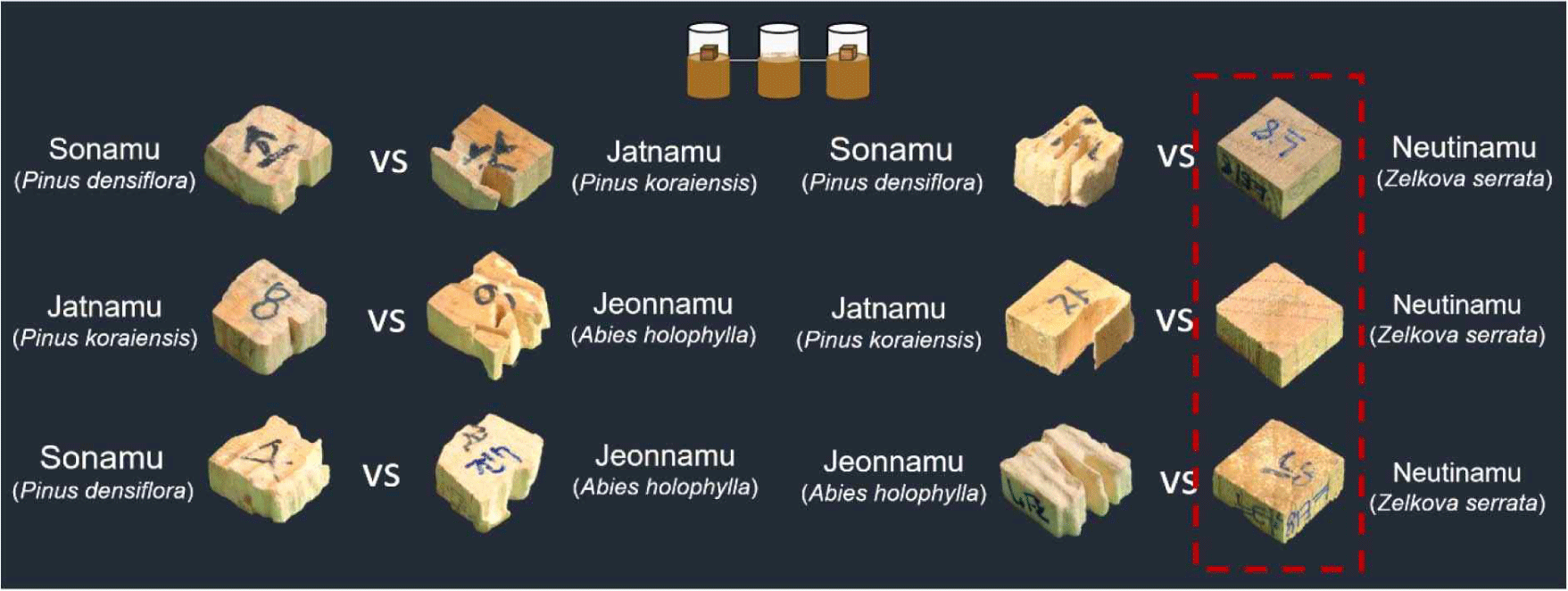
In contrast, P. densiflora and P. koraiensis did not show significant differences in termite resistance. The termite resistance score of both wood species was 4.5, which is higher than that of A. holophylla and lower than that of Z. serrata (Fig. 3, Table 6). Zelkova serrata was found to have the highest termite resistance, with a total score of 6, as it was rarely attacked compared with P. densiflora, P. koraiensis, and A. holophylla. Thus, it can be concluded that the wood members of wooden cultural properties made of Z. serrata with high termite resistance are likely to be at the lowest risk of damage caused by R. speratus among the four main wood members.
The results of the termite resistance analysis for each tree species confirmed that the wood consumption of R. speratus was inversely proportional to the specific gravity of wood and decreased with an increase in the specific gravity of wood (Figs. 4 and 5). However, C. crenata did not follow this trend (Figs. 4 and 5). C. crenata has a specific gravity of approximately 0.49, similar to L. kaempferi, P. densiflora, and P. koraiensis. However, in the no-choice test, the feeding rate of R. speratus on C. crenata was only approximately a quarter that of the three wood species (Table 5). In the same experiment, the feeding rate of R. speratus on P. sargentii and Z. serrata was less than half of the feeding rate on softwood, but the mortality rates were high at 26.5% and 32.3%, respectively (Fig. 4). Based on these results, it can be concluded that the resistance of wood to the termite R. speratus is impacted not only by the specific gravity of wood but also by the extracts contained in the wood. Therefore, to determine the effects of the extracts of different wood species on their termite resistance, we evaluated termite resistance in wood specimens extracted using cold water and organic solvents.
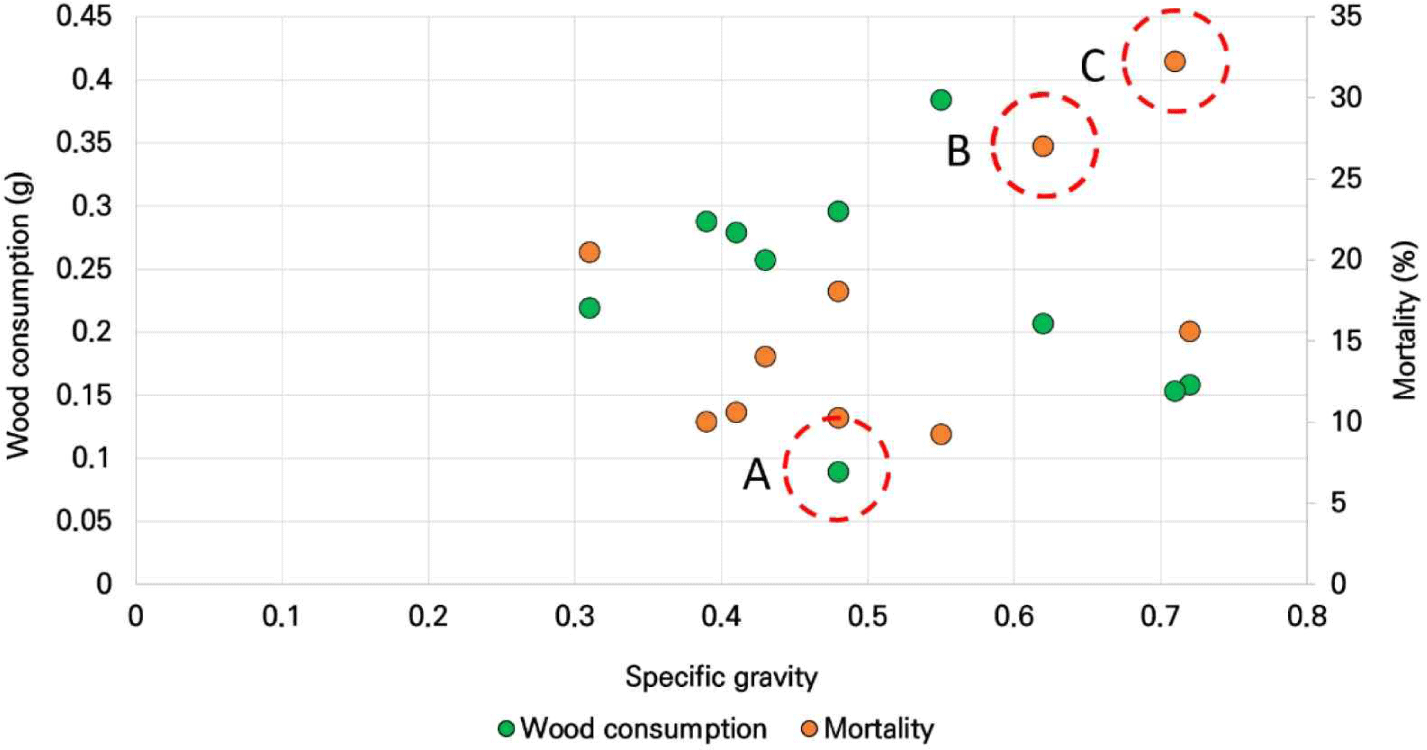
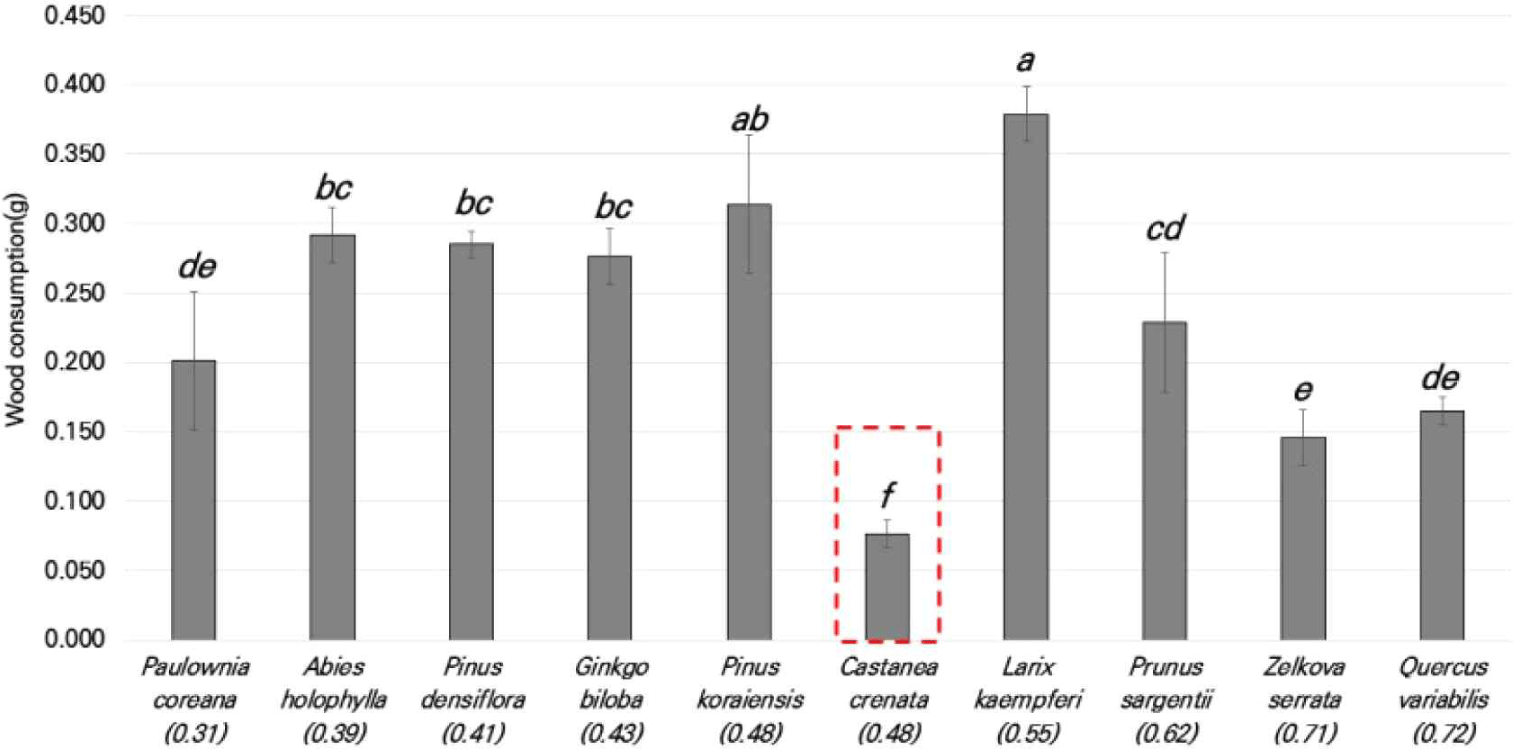
The wood consumption of R. speratus on cold-water extracted P. densiflora, A. holophylla, and L. kaempferi was 1.7, 2.3, and 1.6 times higher, respectively, than that on untreated wood. The wood consumption of R. speratus was 0.8, 1.4, and 1.3 times higher for the alcohol–benzene extracted wood of P. densiflora, A. holophylla, and L. kaempferi, respectively, than that for untreated wood, which, in turn, was lower than that for cold-water extracted wood (Fig. 6). These results suggest that the leaching of water-soluble extracts from the wood specimens of P. densiflora, A. holophylla, and L. kaempferi during cold-water extraction have a positive effect on the wood-feeding activity of R. speratus.
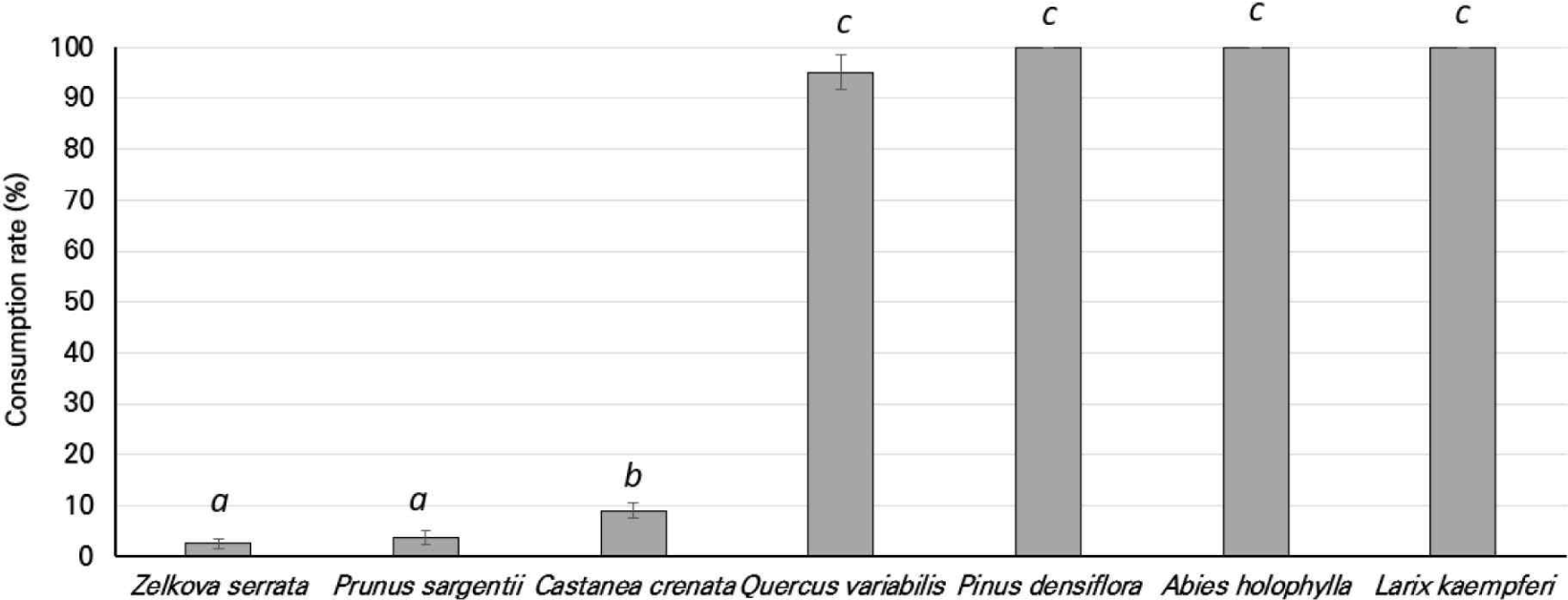
However, in the case of P. sargentii, Q. variabilis, C. crenata, and Z. serrata, the wood consumption of R. speratus feeding on cold-water extracted wood tended to slightly increase to 1.2–1.4 times compared with that of R. speratus feeding on untreated wood; however, the difference was not statistically significant. Accordingly, in the case of hardwood, the leaching of water-soluble extracts did not have a significant effect on the feeding activity of R. speratus; therefore, it is believed that hardwood maintains termite resistance for a longer period than that observed for softwood, even under natural conditions. The wood consumption of R. speratus feeding on alcohol–benzene extracted P. sargentii, Q. variabilis, and C. crenata increased 2-fold, 2.1-fold, and 3.5-fold, respectively, compared with that of R. speratus feeding on untreated wood, and this difference was statistically significant. However, in the case of Z. serrata, a statistically significant difference was not observed in the wood consumption of R. speratus feeding on untreated, cold-water extracted, or alcohol–benzene extracted wood. This result can be attributed to the combination of the high specific gravity of Z. serrata wood of over 0.7 and the small amount of extract that may remain in the wood after extraction. In conclusion, the extract contents and specific gravity of each wood species significantly impacted the wood-feeding activity of R. speratus. More detailed studies are required to determine which extracts of different wood species have inhibitory effects on the feeding activity of R. speratus.
Each wood species was treated with the alcohol–benzene solution to obtain its wood extracts, which were then applied to filter paper and fed to R. speratus for a week. Filter papers coated with the extracts of P. densiflora, A. holophylla, and L. kaempferi were 100% consumed by R. speratus (Fig. 6). The mortality rates of R. speratus fed filter papers containing the alcohol–benzene extracts of wood species were 4.8%, 5.3%, and 5.0% for P. densiflora, A. holophylla, and L. kaempferi, respectively, with a survival rate of approximately 95% (Fig. 7). Accordingly, the alcohol–benzene extracts of P. densiflora, A. holophylla, and L. kaempferi did not have an inhibitory effect on the feeding activity of R. speratus. Even in the case of filter paper coated with Q. variabilis extract, R. speratus ingested 100% of the substrate, and their mortality rate was less than 1%, which was lower than that of R. speratus feeding on softwood extract. Sound Q. variabilis wood has a relatively high termite resistance because of its high specific gravity. However, if its specific gravity is reduced because of deterioration caused by rot fungi in the natural environment, the possibility of being damage caused by R. speratus may increase, as Q. variabilis does not contain extracts resistant to R. speratus. This result is consistent with the results of the forest survey presented in Section 2.2.1. and those of the analysis of the feeding pattern of R. speratus on Q. acutissima presented by Son (2018).
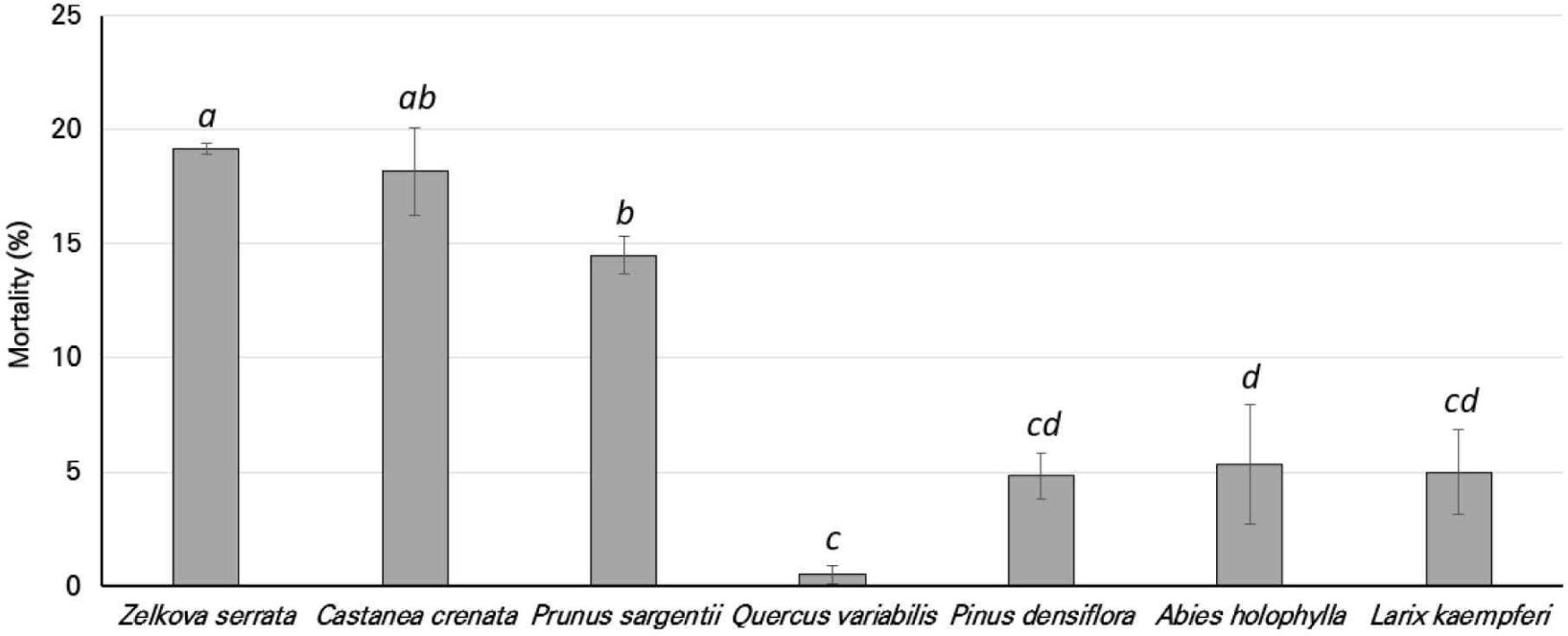
Filter papers coated with the extracts of Z. serrata, P. sargentii, and C. crenata were eaten by R. speratus for a week, with only 2.6%, 3.8%, and 9.0% of Z. serrata, P. sargentii, and C. crenata extract-coated filter papers, respectively, being ingested (Fig. 6). Moreover, the mortality rates of R. speratus feeding on Z. serrata, P. sargentii, and C. crenata extracts were 19.1%, 14.5%, and 18.1%, respectively, 3–4 times higher than the mortality rate of R. speratus ingesting 100% of filter papers coated with the extracts of the other wood species (Fig. 7). Moreover, even when termites consume extracts derived from these three wood species, not all termites are killed. Therefore, these extracts can be considered as substances that exhibit a strong repellent effect against wood feeding rather than substances with insecticidal effects. Regarding the differences in the wood consumption and mortality rates of termites feeding on these extracts, Kofoid and Bowe (1934) reported that chemicals present in the extracts of different wood species suppress termite feeding and kill their intestinal protozoa, thereby increasing the mortality rates of termites. Therefore, the repellent effect of wood extracts prevented individual termites from receiving sufficient food during the experimental period, and the mortality rate increased because of termite starvation.
4. CONCLUSIONS
Resistance to the termite R. speratus was confirmed in Korea’s wooden cultural assets and domestic tree species used in wooden construction. The resistance of the five types of softwood and five types of hardwood species to the termite R. speratus was confirmed through the no-choice test, wherein hardwood species showed higher termite resistance than that exhibited by softwood species. In addition, a comparison of the termite resistance of P. densiflora, A. holophylla, P. koraiensis and Z. serrata, mainly used in wooden structural cultural assets, revealed that A. holophylla had the lowest termite resistance, whereas Z. serrata had the highest termite resistance. Based on these results, it can be concluded that softwood species, including P. densiflora, used as wood members in wooden buildings, are vulnerable to the damage caused by R. speratus, whereas Z. serrata is highly resistant.
In addition, the termite resistance analysis of wood extracted with cold water or alcohol–benzene solution revealed a significantly increased wood consumption of R. speratus for the cold-water extracted wood of P. densiflora, A. holophylla, and L. kaempferi. This result suggests that when wood is exposed to natural environments with continuous moisture inflow, such as rainfall, the feeding activity of R. speratus may be further promoted by the leaching of wood extracts. In contrast, the cold-water extraction of hardwood did not significantly affect the feeding activity of R. speratus; therefore, hardwood is expected to have relatively higher termite resistance over a longer period than exhibited by softwood under natural conditions.
The evaluation of termite resistance using an alcohol–benzene extract of Q. variabilis, which has an extremely low feeding rate on untreated wood, confirmed that the extract did not have a feeding inhibitory effect. In the case of Q. variabilis, the wood consumption of R. speratus is believed to be significantly affected by the specific gravity of wood. In addition, the alcohol–benzene extracts of Z. serrata, P. sargentii, and C. crenata showed a strong feeding repulsion effect, suggesting that the specific gravity of the wood and the chemicals present in the extracts of the wood of these species have a combined inhibitory effect on the feeding activity of R. speratus.
